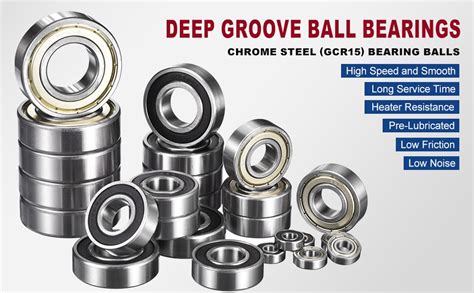Deep Groove Ball Bearings: Revolutionizing Industrial Applications
Introduction
Deep groove ball bearings, renowned for their versatility and durability, are indispensable components in a myriad of industrial applications. Their precision engineering and robust construction enable them to withstand demanding operating conditions, ensuring optimal performance and longevity.
Benefits of Deep Groove Ball Bearings
-
Low Friction: Precision-ground ball bearings minimize friction, reducing energy consumption and maximizing efficiency.
-
High Load Capacity: Enhanced load-carrying capabilities enable deep groove ball bearings to handle both radial and axial loads effectively.
-
Speed Capability: Designed for high-speed applications, these bearings minimize vibration and noise, prolonging equipment lifespan.
-
Cost-Effectiveness: Mass production techniques make deep groove ball bearings an economical choice, offering high value for their performance.
-
Wide Availability: The standardized design and extensive range of sizes ensure easy procurement and interchangeability.
Applications of Deep Groove Ball Bearings
Deep groove ball bearings find applications in diverse industries, including:
- Automotive (engines, transmissions, steering systems)
- Industrial machinery (pumps, motors, compressors)
- Appliances (washing machines, dryers, refrigerators)
- Medical devices (surgical instruments, MRI machines)
- Aerospace (aircraft engines, landing gear)
Design and Construction
Deep groove ball bearings comprise three primary components: an inner ring, an outer ring, and a set of precision-ground balls. The balls circulate within deep, uninterrupted raceways on both the inner and outer rings, maximizing load distribution and minimizing friction.

Lubrication
Proper lubrication is crucial for deep groove ball bearing performance and longevity. Common lubricants include:
-
Oil: Mineral or synthetic oils are widely used for high-speed applications or where cleanliness is essential.
-
Grease: Semi-solid greases provide excellent sealing and protection from contaminants, making them suitable for low-speed applications.
Maintenance and Inspection
Regular maintenance and inspection are essential to ensure optimal bearing performance:
- Monitor operating temperature and vibration levels to detect potential issues.
- Periodically inspect bearings for wear, contamination, or damage.
- Relubricate bearings as recommended by the manufacturer or as operating conditions dictate.
Quality Standards
Internationally recognized standards ensure the quality and reliability of deep groove ball bearings:
-
ANSI/AFBMA Standard 18: Specifies dimensional tolerances, load ratings, and other performance criteria.
-
ISO Standard 15: Defines the basic design, dimensions, and tolerances for deep groove ball bearings.
Performance Considerations
When selecting deep groove ball bearings, consider the following performance factors:
-
Load Capacity: Determine the radial and axial load requirements for the application.
-
Speed: Ensure the bearing meets or exceeds the operating speed requirements.
-
Lubrication: Choose the appropriate lubricant based on operating conditions and maintenance constraints.
-
Environmental Conditions: Consider the presence of moisture, dust, or other contaminants in the operating environment.
Troubleshooting
Common issues with deep groove ball bearings include:
-
Excessive Noise: May indicate misalignment, incorrect lubrication, or bearing damage.
-
Increased Temperature: Excessive friction due to lubrication failure or contamination.
-
Bearing Failure: Caused by overloading, misalignment, or improper installation.
Stories
Story 1
A manufacturing plant experienced persistent bearing failures in their high-speed machinery. The culprit turned out to be an inadequate lubrication schedule, highlighting the importance of timely maintenance.

Story 2
A prototype of a new aircraft failed during a test flight due to a faulty deep groove ball bearing. The investigation revealed a design flaw that had led to premature bearing wear.
Story 3
A contractor was baffled by excessive vibration in a newly installed HVAC system. After replacing countless components, they finally discovered a defective deep groove ball bearing in the fan motor. The bearing had failed due to an incorrect installation, emphasizing the need for proper bearing fitting procedures.
Learning Points
- Regular maintenance and inspection are crucial for bearing performance and longevity.
- Improper lubrication or installation can lead to costly equipment failures.
- Thorough investigations are essential to identify and resolve bearing problems promptly.
Tips and Tricks
- Use high-quality lubricants and adhere to the recommended lubrication intervals.
- Ensure proper alignment of bearings to prevent excessive wear and vibration.
- Protect bearings from contaminants by using seals or shields.
- Monitor operating conditions, such as temperature and vibration, to detect potential issues early.
How to Step-by-Step Approach
- Determine the load, speed, and environmental requirements for the application.
- Select a deep groove ball bearing that meets or exceeds these specifications.
- Prepare the bearing and mounting surfaces according to the manufacturer's instructions.
- Install the bearing using the appropriate tools and techniques.
- Lubricate the bearing as recommended.
- Monitor the bearing's performance during operation and perform regular maintenance.
FAQs
-
What are the different types of deep groove ball bearings?
- Single-row, double-row, and four-row ball bearings.
-
How do I choose the right deep groove ball bearing for my application?
- Consider load, speed, lubrication, and environmental conditions.
-
What are the most common causes of deep groove ball bearing failure?
- Improper lubrication, misalignment, and overloading.
-
How can I extend the lifespan of my deep groove ball bearings?
- Regular maintenance, proper lubrication, and protection from contaminants.
-
What are the benefits of using deep groove ball bearings?
- Low friction, high load capacity, speed capability, cost-effectiveness, and wide availability.
-
What are some industries that use deep groove ball bearings?
- Automotive, industrial machinery, appliances, medical devices, and aerospace.
-
What are the different types of lubrication used for deep groove ball bearings?
- Oil and grease.
-
What are the international standards that apply to deep groove ball bearings?
- ANSI/AFBMA Standard 18 and ISO Standard 15.
Conclusion
Deep groove ball bearings are essential components that enable efficient and reliable operation in a wide range of industrial applications. Their versatility, durability, and cost-effectiveness make them the preferred choice for engineers and manufacturers seeking high-performance bearing solutions. By understanding their design, performance characteristics, and maintenance requirements, one can optimize bearing selection and extend its lifespan, ensuring maximum equipment uptime and productivity.


